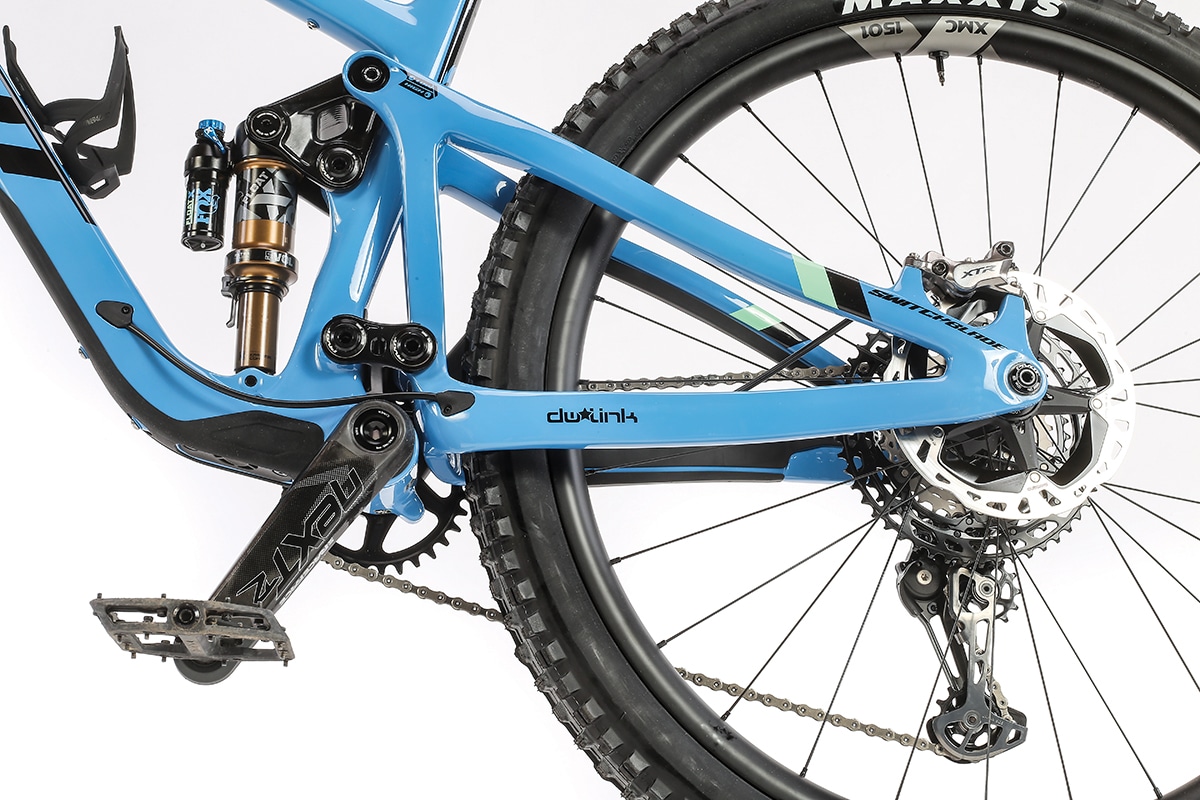LONG TERM REVIEW: PIVOT SWITCHBLADE – A SHARPER TRAIL WEAPON
Pivot's refined third generation Switchblade builds upon the platform that made it one of the best trail mountain bikes

LONG TERM REVIEW: PIVOT SWITCHBLADE – A SHARPER TRAIL WEAPON
Pivot’s third-generation Switchblade is set to build on the model’s reputation as a do-almost-anything mountain bike. According to Pivot, the new model excels in an even broader range of terrain, and that’s saying something, because it’s that versatility that test riders have loved ever since the model was first released in 2016. The second-generation Switchblade was a massive step forward in performance and is still one of the better bikes in its class, so the wrecking crew was eager to see just how much better the latest version is.
FRAME
At a casual glance, the new Switchblade frame does not look all that different from the V2 model. Its carbon front and rear triangles have very similar lines and shapes overall, but the top tube is a bit thinner.
The biggest change with the frame comes in the form of new geometry. In the low flip-chip setting, its head angle is .8 degrees slacker at 65.2 degrees, the seat angle a half-degree steeper at 76 degrees, and the reach about 10mm longer. The chainstay length is the same as before in extra small through medium sizes, but grows slightly and becomes size-specific in large and extra-large sizes. The flip chip allows for steepening of the geometry for more agile handling and increased bottom bracket height or to compensate for the use of 27.5-inch rear wheels. Despite the added reach, Pivot claims the new frame is actually a few grams lighter than the old one.
The seat tube is straighter, allowing for longer dropper-post insertion depths that can reach all the way to the lower DW-link pivot point now. Pivot is still proud to fit a full-size water bottle inside the front triangle in all sizes, including the extra small, and there is a second set of bottle bosses under the downtube as well. Accessory bosses are located under the top tube and under the bottom bracket for Pivot’s Dock line of tools.

SUSPENSION
Perhaps the biggest update on the new Switchblade comes in the form of all-new suspension kinematics. Wheel travel is still the same at 142mm, but it now features a longer lower link that is more like what you see on the Firebird model. The previous-generation shared lower links with the Trail 429 and Mach 4 SL, but now it’s much more like the Firebird in length. Pivot says this longer link and new design give the wheel travel a more rearward wheel path for improved descending performance.
According to Pivot, the Fox Float X shock tune is exactly the same as before with only a small tweak to the air-volume spacer. The front end still sees a 160mm-travel Fox 36 fork.
COMPONENTS
The Switchblade is available in 10 different SRAM- or Shimano-based builds, ranging in price from $6399 to $11,599. It is offered in Blue Neptune, Stealth Mojave and a limited-edition Pink Neon. This limited-edition version celebrates Pivot founder Chris Cocalis’ 35th anniversary of bicycle frame and component manufacturing. Its paint job is a replica of his very first frame, the Sun Eagle Talon.
Our test bike features the Team XTR build and retails for $9899. Its full-XTR drivetrain and brakes deliver proven performance and reliability that’s tough to beat in most regards. Race Face’s Next R carbon cranks offer a bit of carbon bling to the build, but some test riders would have preferred a 5–10mm shorter arm length than the 175mm spec on our size-large test bike.
DT Swiss’ XMC1501 carbon wheels didn’t skip a beat during testing, and their 30mm inner width matched perfectly to the always-superb Maxxis Minion DHF and DHRII tire spec. Pivot’s cockpit components are top-notch, with the handlebar bend and grips receiving high marks from test riders. Fox’s Factory Transfer dropper post worked well throughout testing and gives us little to complain about.

CLIMBING
One big difference was the ability to ride a size down from the previous models. Before, on the V2, some test riders sized up to get the reach they preferred, but the new model is spot-on and more in line with other Pivot models and other brands in the trail and all-mountain categories. One of the first things to jump out at us is the improved rider position. Between that longer reach and touch steeper seat angle, we felt more centered over the bike, particularly while climbing.
With all the talk of enhanced descending prowess, a few of us were worried that it might come at the cost of the Switchblade’s superb ascending capabilities, but we are happy to report that’s simply not the case. The new bike feels just as connected and crisp at the pedals under power, yet the suspension seems a touch more reactive and compliant with the terrain, particularly under power. The rear wheel is seemingly able to track the ground better, and this trait really stands out on rocky, rubbly loose climbs where the bike just seems to find grip and squirt forward.
Even with the slacker head angle, steering feels precise at lower speeds, retaining the overall feel that made the Switchblade a technical-climbing mountain goat.

DESCENDING
As good as it climbs, descents are really where we felt the biggest change. Even though rear-wheel travel remains unchanged, the sensation is that it gained travel; a few riders even thought it did. We were surprised that the kinematic change alone resulted in such a different feel with the exact same shock tune. It’s more supple and active early in the stroke, gluing the rear tire to the ground in places the V2 might have skipped around a bit. And, it seems to have gained composure on harder hits and flat landings, too.
Its rear suspension has a new feel to it that just begs to be pushed harder and slammed into things. The rear wheel may have made an interesting sound or two, but the bike kept straight and felt solid.

A combined change in geometry and rear suspension gives the new Switchblade an even more predictable feel and willingness to be ridden aggressively now. It has a longer feel to the front end, and this seems to really come into play on steeper and faster lines where the longer reach and slacker head angle puts the front wheel farther out in front of the rider’s center of gravity. Yet, it’s not so long that it loses its playfulness at lower speeds; the geometry strikes a perfect balance between a nimble trail bike and enduro smasher.
WHAT DID WE LOVE?
A standout trait of this bike is just how quiet it is. Other than the faint hum of the DT Swiss rear hub, all you can hear is the sound of the Maxxis tires clawing for traction on the trail. We also appreciate that Pivot has not jumped on the headset cable-routing bandwagon; instead, keeping with its proven cable-port system. It makes everything easier any time service is required and is part of the reason the bike is so quiet.

WHAT DID WE HATE?
When a bike is this refined, it’s hard to find things to complain about. Pivot even changed the cable-port cover hardware from the silver we complained about in our Firebird review to black. Some riders don’t put WTB’s Volt saddle at the top of their favorites list, but it’s generally well received. And, some riders who have gotten used to internal frame storage missed it on this bike. Others are happy it’s not there and prefer the external accessory mounts, so this is a very polarizing topic among the wrecking crew.

BOTTOM LINE
The new bike delivers subtle improvements on every front—an impressive feat given how good the previous version was. Unlike the last generation that was a quantum leap ahead in evolution compared to the original model, this one is more of a refinement, and we’re very happy to say that. Pivot took what we loved about the previous Switchblade and added to it without taking away from anything that made it great. From fast-paced, flowy trail rides with lots of climbing to well-traveled, beat-up, chunky steep descents, the V3 Switchblade pushes the fun factor a bit farther out on both sides of the all-mountain spectrum.

PIVOT SWITCHBLADE TEAM XTR
CATEGORY: All-mountain
WHEEL SIZE: 29″
SUSPENSION: 160mm (front), 142mm (rear)
Price: $9,899
Weight: 30.4 pounds (without pedals)
Sizes: XS, S, M, L (tested), XL
Frame tested: Carbon, 142mm travel
Shock: Fox Factory Float X
Fork: Fox Factory 36 29″, 44mm offset, GRIP2, 160mm
Wheelset: DT Swiss XMC1501 w/ 30mm-wide carbon rims
Tires: Maxxis Minion DHF 29” x 2.5″/Maxxis Minion DHRII 29″ x 2.4″
Seatpost: Fox Factory Transfer 125mm (XS), 150mm (SM), 175mm (MD), 200mm (LG–XL)
Saddle: Phoenix WTB Volt Team (medium width) (MD-XL)
Handlebar: Phoenix Team Low Rise Carbon; 760mm (XS), 780mm (SM–LG), 800mm (XL)
Stem: Phoenix Team Enduro/Trail; 35mm (XS); 45mm(SM–XL)
Grips: Phoenix Factory Lock-On
Headset: Pivot Precision sealed cartridge
Brakes: Shimano XTR M9120 4-Piston
Rotors: Shimano XTR CenterLock 203mm (f)/180mm (r)
Rear derailleur: Shimano XTR M9100 SGS 12-speed
Shifters: Shimano XTR M9100 ISPEC EV 12-speed
Crankset: Race Face Next R; 170mm (XS–MD), 175mm (LG–XL)
Bottom bracket: Pivot precision-sealed bearing press-fit
Cassette: Shimano XTR M9100 10-51t
Chain: Shimano CN-M9100 12-speed
Chainrings: Race Face 32-tooth
GEOMETRY:
Head tube angle: 65.7–56.2°
Effective seat tube angle: 76.5–76°
Reach: 485–480mm (19.1–18.9″)
Stack: 639–643mm (25.2–25.3″)
Bottom bracket height: 350–344mm (13.8–13.5″)
Chainstay length: 431–432mm (17″)
Wheelbase: 1,240–1,242mm (48.8–48.9″)




